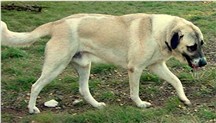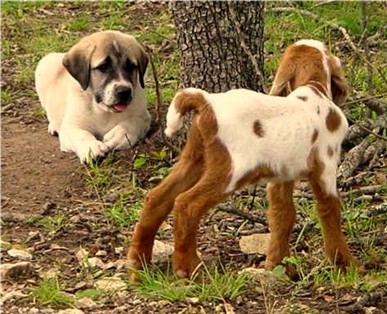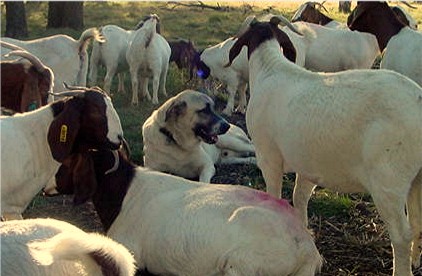|
By Barbara Horn, Taylor and Horn Goat Company, Georgetown, Texas |
||
| Note Major's excellent demeanor and body posture while slowly walking near the goats! |
 Lucky Hit Shadow Major |
With this posture, Major is saying "I'm just politely passing through! No need for alarm!" |
|
I was raised a big city girl in Houston, Texas. My outdoor skills were finely honed selecting the best parking place at the Galleria shopping mall. That life changed radically when I followed my husband's dream of living on a ranch in the country and we moved 30 miles northwest of Austin. We already owned an Australian Shepherd and a Border Collie and bought Barbados sheep to maintain the property's tax exemption. Before long I found a ewe flinging blood all over my front porch, a chuck out of her hip. A predator attack! I was horrified! Two days later we had another incident - no deaths, but several injuries. A few days later we heard that an abandoned dog and her pups were found, captured and adopted by several ranches in the area. The attacks stopped. I learned an important lesson. Sheep are easy prey to hungry predators and need protection. In 1995, I fell in love with goats, specifically South African Boer goats. I bought a full blood doe kid and five half blood does for $2,500.00 - quite a bargain at the time. I presented them to my husband for his birthday - or at least that was my story. We sold the sheep and devoted ourselves to raising high quality Boer goat breeding stock. We flushed the full blood doe, got 22 embryos, implanted 18 in recipient goats and had 15 very expensive full blood kids on the ground that spring, greatly increasing the importance of predator control. Predators at our ranch are usually either hungry coyotes or dog packs roaming in the night and killing for the sport of it. To protect our goats we initially purchased two Great Pyrenees and raised them with the goats. They lost all the hair around their eyes when they were three months old. The city vet we had been using diagnosed the problems as Demodectic mange and declared that the condition was genetic. We treated them with ivermectin and they recovered. When they were seven months old, the female grew a large mass on her shoulder, and eventually we had to put her down. Realizing how important flock guardian dogs are in effectively protecting our goats, we bought a replacement female Great Pyrenees, Daisy, from a different breeder. When our original male Pyr died a few years later from a knee infection after joint surgery, we replaced him with Gringo, a Great Pyrenees cross we obtained from a big commercial goat breeder in West Texas. Over the years, we increased the size of our Boer goat herd by purchasing quality breeding stock from some of the top bloodlines in the country. Our steady increase in our financial investment in the goats made effective predator control a necessity. So when I noticed my neighbors had lost eight lambs in a short period of time, I stopped by to ask what was happening to them. She said a large cat print was found by their barn. A few days later, I heard there were several mountain lion sightings in our area. And when my housekeeper said she saw a mountain lion crossing the pasture next to us, I freaked! When I calmed down, I realized my Pyrs must have been providing protection, since we had not suffered an attack. However, if a big cat decided to grab one of my kids, I wasn't confident my Pyrs would stand up to it. About this time, a dear goat friend, Erick Conard, one of the top working Anatolian Shepherd breeders in the country, had a litter of pups. Erick was very excited about this litter because he was breeding to a Sakarya Kennels male. After much introduction to Erick's excellent dogs, which guard Erick, his goats, and everything else on his ranch, I purchased one of Erick's male pups and named him Lucky Hit's Shadow Major, Major for short - our awesome Anatolian Shepherd. Major was recommended based on Erick's experience with the pup's behavior. Major enjoyed spending time lounging around with the goats, displayed excellent demeanor and posturing with goats, and evidenced other subtle characteristics Erick uses to evaluate a pup's potential as a working dog.  Lucky Hit Shadow Major at nine weeks already showing excellent guardian behaviors In preparation for Major's homecoming, I had our male Pyr, Gringo, neutered. Our other Pyr, Daisy, had already been spayed. We decided to leave Major intact to preserve his superior working bloodline and to have Major available as a genetic reservoir. As it turns out, this was a good decision. Erick spent a great deal of time discussing working Anatolian character and behavior with us, including an Anatolian's nature to meet aggression with even greater aggression. He also explained how sensitive and responsive Anatolians are and that Anatolians should never be hit under any circumstance! We also discussed the huge investment in time and effort it takes to ensure that a working Anatolian pup is maintained in the correct environment so that the pup properly develops into in a reliable working Anatolian. Using the internet, I read as much as I could find about the breed to make sure I knew what I was getting into. It was clear that from the start - I would have to present myself as the alpha female. We brought Major home when he was ten weeks old. Major's litter was raised at Erick's with mature, big-horned goats; goats who knew how to keep the pups in line when they got frisky but who were not dog vicious, a very important balance. Erick stressed that it was very important that the aggression level of goats housed with an Anatolian pup match the pup's level of aggressive play. Erick cautioned us that as Major matured, his level of aggression in play would increase, requiring that he be placed with stronger goats to maintain his proper attitude of goat respect. Erick indicated that weak willed goats unable to stop Major's puppy play must be removed immediately and that keeping Major with goats of the proper strength would require quite a bit of time and observation. Initially I put Major in the pasture with some yearling does, along with my Saanen goat, Sadie. My idea was to bond Major to goats I planned to keep so he would have some continuity in the herd. I thought Sadie was a pretty strict goat (although hornless) and wouldn't let him get away with any rough play with her or her kids. This plan was in line with Erick's method of placing a pup only with goats who didn't tolerate play. In the first weeks, Major was very much the puppy and was extremely sweet with all the goats. He grew at a surprisingly fast pace. We took care to introduce him to our other dogs slowly (the Pyrs and the house dogs) and only under our careful supervision. At the time, he played with the Pyrs, who were much larger and dominant. That did not last long. When Major was five to six months old and food or attention were involved, he started displaying aggressiveness toward the other guard dogs. During this time of adjustment I brought out the morning dog cookies and left them in my coat pocket. This proved to be a bad plan. The dogs got into a real fight over the cookies and Major swiftly won. Two mature Pyrs against one young Anatolian puppy and the puppy won! Since that day Major has won every disagreement. That incident taught me another lesson. Don't create situations that promote competition. It also gave me confidence that I now had a dog who had the internal strength of will to stand against a mountain lion! What a feeling of relief! The conflict between Major and the Pyrs caused me to begin observing the different guarding styles between the breeds. My Great Pyrenees seem to guard by being big, intimidating and barking (a lot). My Pyrs also tend to frequently roam outside their domain (a tendency I've heard has become more common among Pyrs as they've lost their ability to properly bond to goats or sheep though poor breeding selection). My Pyrs hop my fences in order to move around the neighborhood (very frustrating). As a young pup, Major easily followed the Pyrs over the fence, but this didn't last long. There was a crucial time in Major's development in which he decided to stay with his goats even through the Pyrs left. Since then I've only seen him go over the fence to chase off a neighbor's dog and then promptly return. Although Major can easily clear my fences, he chooses to stay with his goats. This type of animal bonding only results from careful breeding for proven working ability. With the Pyrs out of the pasture and Major entering his "teenage" stage, Major became bored and began looking around for playmates. He knew that the mature horned goats would not tolerate his puppy play so he focused on the younger goats. (Although I knew to keep Major only with goats strong enough for his level of play, I wasn't able to sort my animals that way. Major was now with the whole herd.) I observed that Major became most active in his play with the goats while he was waiting for me to bring his food. Because I didn't have Major placed with goats of sufficient strength, I occasionally found him playing just a bit too roughly with the shyest goat in the herd. I checked and found little nicks on that goat's legs. Once Major must have gotten carried away with his play because the nick was severe enough that he temporarily crippled a new goat I had brought into the herd. She was the most reticent goat and had no status with the other goats. It is interesting to me that when this goat kidded, Major was especially protective of her babies and would not let the Pyrenees around them. Except for that one incident, Major's rough play behavior was very minor and lasted only a few weeks. Since I wasn't able to place him only with tougher goats and I needed to keep him with my goats for their protection, I was on the watch for this gripping behavior. Major only played with the smallest animals and never to a bad end. Generally they would limp for a couple of hours and recover. The few times I caught him in the act, I would yell "No" and "Bad," both of which he understood and would immediately back off. He seemed confused that his play irritated me, as if he were just having fun with a friend. Although this behavior only lasted a few weeks with Major, I've heard that it frequently lasts up to a year or more in some working Anatolians. So I really consider myself lucky to have picked Major! Major has been an excellent addition to the ranch. Erick taught him very early on to "back off" when so instructed. This command has come in handy many times. When the male Pyr gets too invasive of Major's space, they sometimes get into a fight. I can stand by and yell "Back Off," and Major will stand down. We are also using a technique with Major in which good times and appropriate behavior result in baby talk and petting while inappropriate behavior results in the loud, harsh "Back-off" command, which works very well. Being the alpha female has its privileges.  Lucky Hit Shadow Major with his goats Major has become an important member of our ranch and seems to have come into his own as he reached about 16 to 18 months of age. The goat-gripping is a faint memory from the past. Major is very protective of the kids without hovering over them. When I sell a goat that is to be taken off our property, Major becomes upset having his goats harrassed and I have to hold him back to get the trailer out of the pasture. Major, not a barker, is a "stealth" watchdog with incredible power, size and ferocity when required. Major has given our ranch a great new feeling of safety. And that, my friends, is how a major mall girl came to own a powerful and protective Anatolian Shepherd named Major! |
Link to Lucky Hit Ranch Main Home Page
Link to Lucky Hit Ranch Anatolian Page